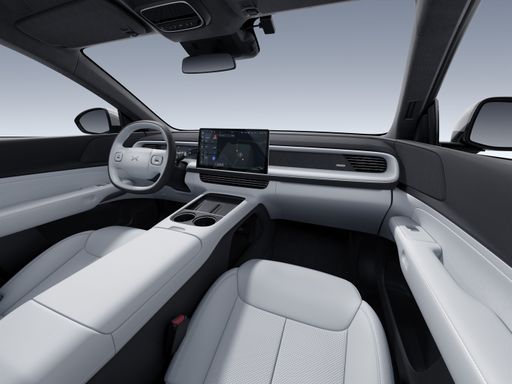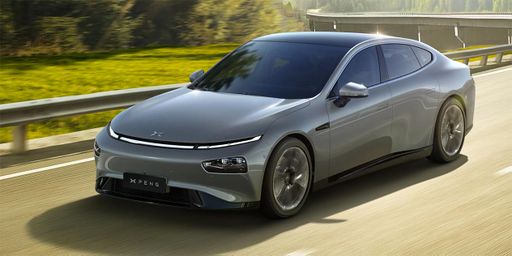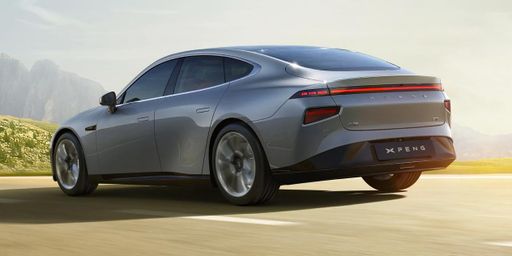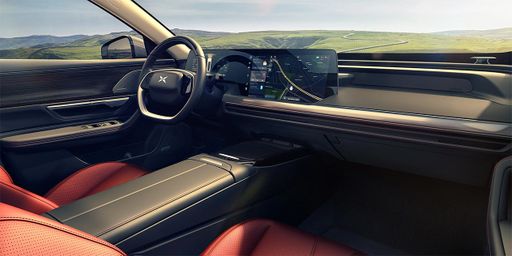The electric vehicle landscape is continuously evolving, and XPeng Motors is at the forefront with two standout models: the XPeng G6 and XPeng P7. Each vehicle targets different segments while offering cutting-edge technology, impressive performance, and extensive range. This article will take a closer look at how these two models compare across key technical aspects and innovations.
XPeng G6 vs XPeng P7 – Which car suits you better?
Two cars, one duel: XPeng G6 meets XPeng P7.
Which one wins in performance, efficiency and value for money? Find out now!
Design and Body Type
The XPeng G6 is positioned as a sleek SUV, showcasing a modern aesthetic that appeals to those who desire spaciousness and an elevated driving position. With dimensions of 4753 mm in length, 1920 mm in width, and 1650 mm in height, the G6 offers considerable road presence.
On the other hand, the XPeng P7 takes the form of a sophisticated sedan. It stretches longer at 4888 mm while being narrower (1896 mm) and much shorter in height (1450 mm). This design lends itself well to aerodynamics and performance, particularly for those who prioritize sportiness and elegance.
Performance and Powertrain
Both the G6 and P7 employ electric powertrains that offer exceptional performance with various horsepower options. The XPeng G6 offers two electric motor configurations: a 286 HP and 476 HP variant, along with a torque output of up to 660 Nm, ensuring thrilling acceleration. The vehicle can sprint from 0-100 km/h in just 4.1 seconds in its performance variant.
In comparison, the P7 comes equipped with a maximum power of 276 HP and 473 HP, paired with an impressive torque of 757 Nm in its higher configuration. The acceleration figures mirror that of the G6, achieving 0-100 km/h in 4.1 seconds. Both vehicles have a top speed capped at 200 km/h, making them fast challengers in the electric vehicle segment.
Electric Range and Consumption
When it comes to electric range, the XPeng G6 stands slightly shorter with a maximum range of 570 km, while the P7 takes the lead with an impressive range of 576 km. This provides the P7 with a marginal advantage, especially for long-distance travelers. On the consumption front, the G6 records figures of 17.5-17.9 kWh/100 km, while the P7 performs more efficiently at 16.8-19.2 kWh/100 km, reflecting XPeng's commitment to maximizing battery efficiency.
Battery Capacity and Charging
The battery technology in both models is commendable. The G6 comes with battery capacities of either 66 kWh or 87.5 kWh, whereas the P7 is equipped with an 82.7 kWh battery. These capacities allow for competitive charging times and add versatility for users looking for efficiency.
Interior and Comfort Features
Both vehicles can comfortably seat five passengers but differ in trunk capacity, with G6 offering 571 liters, while P7 has a slightly smaller capacity of 440 liters. This additional space in the G6 enhances its appeal as a family-friendly SUV, able to accommodate more luggage and gear for adventures.
Innovations and Technology
Both the XPeng G6 and P7 boast advanced technology features that seamlessly blend convenience with safety. Each model comes equipped with XPeng's intelligent driving assistance systems, which enhance the driving experience through features like adaptive cruise control, lane keeping assist, and their latest NGP (Navigation Guided Pilot) capabilities.
Moreover, both vehicles sport state-of-the-art infotainment interfaces that include large touchscreens, voice recognition, and smartphone tethering options, ensuring that drivers remain connected on the go.
Conclusion
In conclusion, the XPeng G6 and P7 each offer unique attributes catering to diverse preferences. The G6 excels in versatility and space, appealing to those wanting a family-oriented SUV, while the P7 draws in those interested in a sporty and efficient sedan experience. Ultimately, the choice between the two boils down to individual needs, but both models represent XPeng's commitment to redefining the electric vehicle market.
Here’s where it gets real: The technical differences in detail
Costs and Efficiency:
When it comes to price and running costs, the biggest differences usually appear. This is often where you see which car fits your budget better in the long run.
XPeng G6 has a slight advantage in terms of price – it starts at 40800 £, while the XPeng P7 costs 42500 £. That’s a price difference of around 1714 £.
In terms of energy consumption, the advantage goes to the XPeng P7: with 16.80 kWh per 100 km, it’s barely noticeable more efficient than the XPeng G6 with 17.50 kWh. That’s a difference of about 0.70 kWh.
As for range, the XPeng P7 performs minimal better – achieving up to 576 km, about 51 km more than the XPeng G6.
Engine and Performance:
Power, torque and acceleration say a lot about how a car feels on the road. This is where you see which model delivers more driving dynamics.
When it comes to engine power, the XPeng G6 has a hardly perceptible edge – offering 487 HP compared to 473 HP. That’s roughly 14 HP more horsepower.
Both models accelerate almost equally fast – 4.10 s from 0 to 100 km/h.
There’s no difference in top speed – both reach 200 km/h.
There’s also a difference in torque: XPeng P7 pulls somewhat stronger with 757 Nm compared to 660 Nm. That’s about 97 Nm difference.
Space and Everyday Use:
Whether family car or daily driver – which one offers more room, flexibility and comfort?
Both vehicles offer seating for 5 people.
In curb weight, XPeng P7 is minimal lighter – 2020 kg compared to 2115 kg. The difference is around 95 kg.
In terms of boot space, the XPeng G6 offers noticeable more room – 571 L compared to 440 L. That’s a difference of about 131 L.
When it comes to payload, XPeng G6 hardly perceptible takes the win – 475 kg compared to 430 kg. That’s a difference of about 45 kg.
Who comes out on top?
Overall, the XPeng G6 shows itself to be edges out slightly and secures the title of DriveDuel Champion.
It convinces with the more balanced overall package and proves to be the more versatile choice for everyday use.
 @ XPeng Motors
@ XPeng Motors
XPeng G6
XPeng G6
The XPeng G6 represents a bold leap forward in the realm of electric vehicles, combining sleek design with cutting-edge technology. This model offers an impressive range that makes it a formidable choice for long-distance travel, while its interior exudes sophistication and comfort. Additionally, advanced driver-assistance features ensure that the driving experience remains both safe and enjoyable, setting a new standard in automotive innovation.
details @ XPeng Motors
@ XPeng Motors
 @ XPeng Motors
@ XPeng Motors
XPeng P7
The XPeng P7 is a sleek and stylish electric saloon that embodies the future of automotive innovation. With its modern design and advanced technology, it offers an impressive driving experience, combining luxury with sustainability. The interior is thoughtfully designed to provide comfort and convenience, making it a strong contender in the competitive market of electric vehicles.
details @ XPeng Motors
@ XPeng Motors
 @ XPeng Motors
@ XPeng Motors
 @ XPeng Motors
@ XPeng Motors
 @ XPeng Motors
@ XPeng Motors
|
 @ XPeng Motors
@ XPeng Motors
|
|
|
|
Costs and Consumption |
|
|---|---|
|
Price
40800 - 44200 £
|
Price
42500 - 50200 £
|
|
Consumption L/100km
-
|
Consumption L/100km
-
|
|
Consumption kWh/100km
17.5 - 18.4 kWh
|
Consumption kWh/100km
16.8 - 19.2 kWh
|
|
Electric Range
510 - 525 km
|
Electric Range
505 - 576 km
|
|
Battery Capacity
80 kWh
|
Battery Capacity
82.70 kWh
|
|
co2
0 g/km
|
co2
0 g/km
|
|
Fuel tank capacity
-
|
Fuel tank capacity
-
|
Dimensions and Body |
|
|---|---|
|
Body Type
SUV
|
Body Type
Sedan
|
|
Seats
5
|
Seats
5
|
|
Doors
5
|
Doors
5
|
|
Curb weight
2115 - 2220 kg
|
Curb weight
2020 - 2140 kg
|
|
Trunk capacity
571 L
|
Trunk capacity
440 L
|
|
Length
4758 mm
|
Length
4888 mm
|
|
Width
1920 mm
|
Width
1896 mm
|
|
Height
1650 mm
|
Height
1450 mm
|
|
Max trunk capacity
1374 L
|
Max trunk capacity
-
|
|
Payload
470 - 475 kg
|
Payload
430 kg
|
Engine and Performance |
|
|---|---|
|
Engine Type
Electric
|
Engine Type
Electric
|
|
Transmission
Automatic
|
Transmission
Automatic
|
|
Transmission Detail
Reduction Gearbox
|
Transmission Detail
Reduction Gearbox
|
|
Drive Type
Rear-Wheel Drive, All-Wheel Drive
|
Drive Type
Rear-Wheel Drive, All-Wheel Drive
|
|
Power HP
296 - 487 HP
|
Power HP
276 - 473 HP
|
|
Acceleration 0-100km/h
4.1 - 6.7 s
|
Acceleration 0-100km/h
4.1 - 6.7 s
|
|
Max Speed
200 km/h
|
Max Speed
200 km/h
|
|
Torque
440 - 660 Nm
|
Torque
440 - 757 Nm
|
|
Number of Cylinders
-
|
Number of Cylinders
-
|
|
Power kW
218 - 358 kW
|
Power kW
203 - 348 kW
|
|
Engine capacity
-
|
Engine capacity
-
|
General |
|
|---|---|
|
Model Year
2025
|
Model Year
2024
|
|
CO2 Efficiency Class
A
|
CO2 Efficiency Class
A
|
|
Brand
XPeng
|
Brand
XPeng
|
Is the XPeng G6 offered with different drivetrains?
Available configurations include Rear-Wheel Drive or All-Wheel Drive.
The prices and data displayed are estimates based on German list prices and may vary by country. This information is not legally binding.
